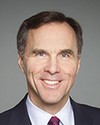I think that the basis from which we start our planning is critically important to help Canadians understand where we are. We've seen, as you just outlined, a difficult period of growth over the last year. There were two impacts to that. One was lower growth than was expected, which in our estimation was because of the wrong policy choices of the previous government. Growth was very low.
We also had a very low inflation rate, so nominal GDP as something that's added up by real growth and inflation was very low. In 2016, when you look at nominal GDP, which you were looking at, you see two separate factors. You see factor number one, which is the real expected growth, which is the number that I spoke about earlier in speaking to private sector economists. They've downgraded that from an expectation of 2% to 1.4%, and added on top of that is what the expectation is of inflation, which we expect will be low in this calendar year. When you add those two numbers, you get to the total number which I believe you referenced as 2.4% nominal.
What we expect will happen in 2017 is that inflation will move closer to the Bank of Canada's targeted inflation rate, which is 2%, which has a significant impact on nominal GDP, and that growth will improve. We expect that this will be as a result, at least in part, of positive policy actions taken by the new government.

